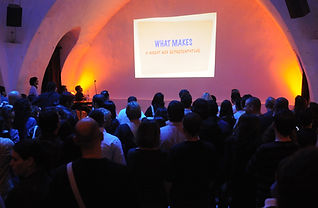21 THINGS A SKILLED ORATOR NEVER DOES:
A Checklist for Public Speakers
By Karyn J. Taylor
Ask any group of people what five things they’re most afraid of and you will invariably find “public speaking” near the top of the list. The reason is simple: most people have a very human fear of being “exposed” and share a universal reluctance to put themselves in a position where others can view, judge, and (perhaps) criticize them.
But media trainers and speaking coaches all know that there is a simple solution for stage fright: focus on imparting your message, not on yourself. After all, you’re on that stage or in that courtroom because you want to persuade, convince, or inspire your audience to do something. You therefore have a “story” to deliver and the audience is there because they want to hear it. Shifting focus onto your audience is not just a ploy; it's a necessity. And it works like a charm. Once you're focused on giving your audience what it needs

to be persuaded or inspired, you’ve long since forgotten about your discomfort at being on display and you’re well into "the zone.”
So the #1 thing a skilled orator never does is...focus on himself. But that’s not to say that a good orator ignores what the audience thinks. Au contraire, mon cher. A good orator is attuned to his or her audience. In fact, he/she modulates the performance according to the audience’s reaction. But worry what the audience is thinking about his/her looks, clothes, personality, politics, or anything else unrelated to the message to be delivered or the goal to be reached? Never.
Come to think of it, there are a few other things a skilled orator never does. A skilled orator never, ever...

#2
Fails to present his/her facts and information in the form of a simple, but compelling story. (Storytelling is integral to the way most people process and understand information.)
#3
Forgets that the only way to motivate an audience to take action is to give them an emotionally compelling reason to do so (regardless of whether that action is finding for your client, voting you into office, or pounding the pavement to boost sales.)
#4
Forgets that the only emotionally compelling reason that matters to anybody is, “What’s in it for me?” (Answer that question in some way in every speech, every time, and you’ll be well on your way to following the likes of Tony Robbins, Gerry Spence, or Dr. Norman Vincent Peale into the pantheon of all time speaking greats!)

#5
Forgets that today’s audiences are part of the Television Generation and are trained to learn not just orally, but visually. (Smart orators use well-designed graphics that help simplify complex material, aid understanding, and boost retention by more than 60%.)'
#6
Tries to cram everything s/he thinks the audience ought to know into one interminably long presentation. (The attention span of the average person is only 18 minutes. Presentations are best given in short sections that add up to less than 40 minutes total.)
#7
Fails to avail him/herself of state-of-the-art presentation software that permits the instant display of documents, graphics, photos, or videotape with the click of a mouse or the flick of a light wand.
#8
Uses so many meaningless slides or overheads that he/she is upstaged by his/her own presentation.
#9
Turns his/her back to the jury/audience while presenting–--even when pointing to slides on a projection screen.
#10
Uses electronic equipment without having had a “tech run through" far enough in advance to fix any technical problems--–or to replace technical equipment if need be--–long before the audience arrives.

#11
Keeps the jury or the audience waiting while he/she shuffles through papers, boxes of exhibits or demonstratives. (Being disorganized wastes precious time, kills the momentum, annoys the judge/jury/ audience, engenders hostility, and undermines credibility.)
#12
Stops mid-sentence to drink water, take notes, speak to technical personnel or to do anything that stops the flow of information, interrupts the train of thought or breaks the jury's or the audience's concentration.
#13
Speaks in “techno-speak” that may go right over the jury’s or audience’s head.

#14
Fidgets, jangles pocket change, paces back and forth, or exhibits any other annoying or distracting behavior while "on stage." He/she has practiced on videotape or with a coach in advance to eliminate such nervous habits.)
#15
Wears anything that draws attention to itself, whether an outfit, a suit, a hairdo, a tie, a pair of shoes, a watch or a piece of jewelry.
#16
Grips the podium like a shipwreck survivor hanging on for dear life.
#17
Takes questions from the audience during Q & A without preparing the answers to anticipated questions well in advance. (In court, a skilled litigator never designs his/her presentation without building in the answers to the very questions the jury will most likely ask in the jury room.)
#18
Speaks in a voice too soft or breathy to be heard at the back of the room. (The best orators hire voice coaches to improve their speaking voices and techniques.)

#19
Reads word-for-word from a prepared script. (Reading your speech, Opening Statement, Closing Argument, or PowerPoint slides doesn’t help you “get it right”; it merely telegraphs that you don’t really know your material and came unprepared!)
#20
Begins a speech in an unfamiliar room. He or she visits the location to get his/her bearings and get “comfortable in the space” long before the audience arrives.
#21
Heads into a presentation--–ANY presentation--–planning to “wing it.” He or she has practiced until the pace is perfect, the visual aids pop up like clockwork, and he/she can deliver the presentation with passion and conviction.


Now that's what skilled orators never do. But what DO they do? The same thing that any concert pianist, rock star, basketball star, or wannabe star always does: PRACTICE! PRACTICE! PRACTICE!
You want me to tell you something different? Nope. Not a chance.
(c) 2005 The Strategic Image

